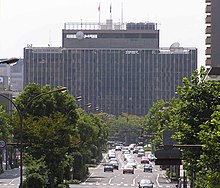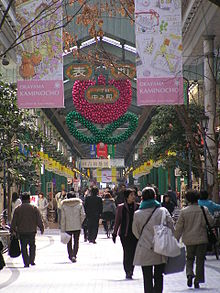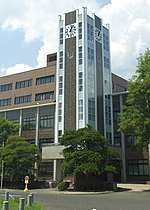Okayama
The Okayama metropolitan area, centered around the city, has the largest urban employment zone in the Chugoku region of western Japan.Before the Muromachi period, Okayama was one corner of a farm region and included a small castle built by the Kanemitsu.Continuing its economic development, Okayama became one of the ten best large castle towns in Japan in the 18th century.During Japan's economic boom of the 1960s, Okayama developed rapidly as one of the most important cities in the Chūgoku and Shikoku regions.In 1988, the Seto-Ōhashi Bridge was opened, and connected Okayama with Shikoku directly by rail and road.The northern part of the city forms a corner of Kibi Plateau, which is a series of gentle hills, and includes the Asahikawa Dam, Okayama Airport, and a suburban residential area.In 2005, the city's gross domestic product was 800 billion yen,[12] nearly 10% of the GDP of Okayama Prefecture.The headquarters of Aeon Corporation, a private English language school with more than 3,000 employees, is located in Okayama.[citation needed] JR West's Okayama Station is a major interchange, with trains from Shikoku, Sanin and San'yo connecting to the San'yō Shinkansen.Okayama has several traditional dishes.Barazushi, a dish made with sushi rice, contains fresh fish from the Seto Inland Sea.Kibi dango (Okayama) (吉備団子) gel-like balls made from a powder of millet and rice, are well known sweets from the area.






Okayama PrefectureOkayama (disambiguation)Designated cityOkayama CastleKōraku-enKibitsu JinjaKibidangoRegionChūgokuSan'yōPrefectureOkayamaTime zoneRed-crowned craneChrysanthemumIlex rotundaLagerstroemia indicacapitalChūgoku regionJapanese castlesMomotarōMuromachi periodSengoku periodUkita NaoieBizen ProvinceUkita HideieBattle of SekigaharaKobayakawa HideakiOkayama DomainHimeji DomainIkeda TsunamasaMeiji governmentEmpire of Japanfeudal domain systemMeiji periodSan'yo Main LineWorld War IIImperial Japanese ArmyUS Army Air Forcesincendiary bombsShikokuSan'yō ShinkansenShin-ŌsakaHakataSeto-Ōhashi Bridgecore cityMitsu DistrictNadasakiKojima DistrictTakebeAkaiwa DistrictHonshūAsahi RiverYoshii RiverSeto Inland SeaAkaiwaHayashimaKibichūōKumenanKurashikiMisakiSetouchiTamanoKöppen climate classificationhumid subtropicalprecipitationrelative humiditysunshine hoursmayor-councilunicamerallower houseDiet of JapanKita-kuNaka-kuHigashi-kuMinami-kuMetropolitan Employment AreaOkayama StationAeon CorporationOkayama Universityjunior collegeshigh schoolsjunior high schoolselementary schoolsChugoku Gakuen UniversityInternational Pacific UniversityNotre Dame Seishin UniversityOkayama Shoka UniversityOkayama University of ScienceSanyo Gakuen UniversityShujitsu UniversityJR WestOkayama AirportKōnan Airportgeneral aviationSan'yoSan'yō Main LineMantomiHigashi-OkayamaTakashimaNishigawaraKitanagaseNiwaseAkō LineSaidaijiUno LineBizen-NishiichiBitchū-MishimaHikosakiBizen-KataokaHazakawaSeto-Ōhashi LineUematsuTsuyama LineHōkaiinBizen-HaraTamagashiMakiyamaNonokuchiKanagawaFukuwatariKibi LineBizen-MikadoDaianjiBizen-IchinomiyaKibitsu




